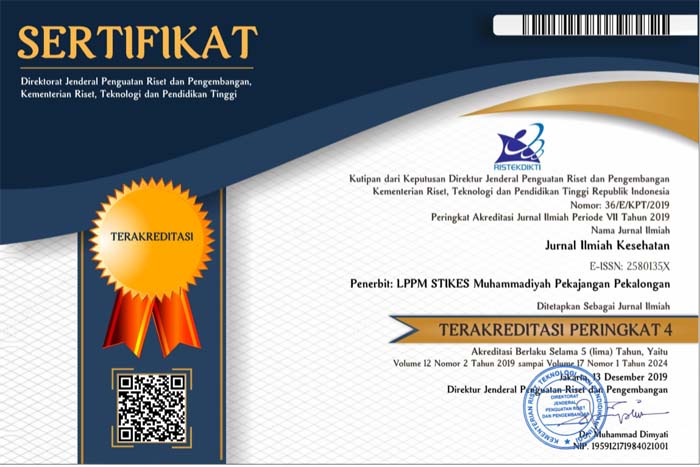Tatalaksana Serangan Gout Akut: Sebuah Tinjauan dari Tiga Pedoman
DOI:
https://doi.org/10.48144/jiks.v16i1.1197Keywords:
Serangan gout, Kolkisin, OAINS, Steroid, Nyeri sendiAbstract
Acute gout flare is one spectrum of gout disease. The flare is characterized by severe acute pain with signs of inflammation at the joint. Currently, there are three primary guidelines in managing gout flares, namely American College of Rheumatology (ACR), European League Against Rheumatism (EULAR), and Indonesian Rheumatology Association (IRA). The objective of this review is to analyze the management of gout flares among these guidelines. We compared three guildelines on managing acute gout flare based on their acute therapy initiation time, first-line treatment, additional treatment, and urate-lowering therapy initiation. Additional literature search was also conducted on PubMed and ScienceDirect to provide additional information to the guideline. All guidelines agreed that management of gout flares should be initiated as early as possible with colchicine or NSAIDs based on patient condition and contraindications. Oral or injected corticosteroid should be considered in patient with renal impairment or contraindications to colchicine or NSAIDs. In conclusion, most recommendations from three guidelines were similar. IRA 2018 are still suitable for managing acute gout flare for Indonesian population
References
G. Ragab, M. Elshahaly, and T. Bardin, “Gout : An old disease in new perspective – A review,” J. Adv. Res., vol. 8, no. 5, pp. 495–511, 2017, doi: 10.1016/j.jare.2017.04.008.
R. Murdoch et al., “Gout, Hyperuricaemia and Crystal-Associated Disease Network (G-CAN) common language definition of gout,” RMD Open, vol. 7, no. 2, pp. 1–7, 2021, doi: 10.1136/rmdopen-2021-001623.
K. Yip and J. Berman, “What Is Gout?,” JAMA Patient Page, 2021, doi: 10.1002/acr.24180.
B. W. Coburn and T. R. Mikuls, “Treatment Options for Acute Gout,” 2016. [Online]. Available: www.fedprac.com.
M. Kumar, N. Manley, and T. R. Mikuls, “Gout Flare Burden, Diagnosis, and Management: Navigating Care in Older Patients with Comorbidity,” Drugs and Aging, vol. 38, no. 7, pp. 545–557, 2021, doi: 10.1007/s40266-021-00866-2.
T. Fu et al., “Associated factors with functional disability and health-related quality of life in Chinese patients with gout: A case-control study,” BMC Musculoskelet. Disord., vol. 18, no. 1, pp. 1–10, 2017, doi: 10.1186/s12891-017-1787-7.
J. D. FitzGerald et al., “2020 American College of Rheumatology Guideline for the Management of Gout,” Arthritis Care Res. (Hoboken)., vol. 72, no. 6, pp. 744–760, Jun. 2020, doi: 10.1002/ACR.24180.
P. Richette et al., “2016 updated EULAR evidence-based recommendations for the management of gout,” Ann. Rheum. Dis., vol. 76, no. 1, pp. 29–42, 2017, doi: 10.1136/annrheumdis-2016-209707.
Perhimpunan Reumatologi Indonesia, Rekomendasi Pedoman Diagnosis dan Pengelolaan Gout. 2018.
N. Rashid, G. D. Levy, Y.-L. Wu, • Chengyi Zheng, • River Koblick, and • T Craig Cheetham, “Patient and clinical characteristics associated with gout flares in an integrated healthcare system,” Rheumatol. Int., vol. 35, pp. 1799–1807, 2015, doi: 10.1007/s00296-015-3284-3.
T. Neogi et al., “2015 Gout classification criteria: An American College of Rheumatology/European League Against Rheumatism collaborative initiative,” Ann. Rheum. Dis., vol. 74, no. 10, pp. 1789–1798, 2015, doi: 10.1136/annrheumdis-2015-208237.
P. Richette et al., “2018 updated European League against Rheumatism evidence-based recommendations for the diagnosis of gout,” Ann. Rheum. Dis., vol. 79, no. 1, pp. 31–38, 2020, doi: 10.1136/annrheumdis-2019-215315.
Q. Li et al., “Diagnosis and treatment for hyperuricemia and gout: a systematic review of clinical practice guidelines and consensus statements,” BMJ Open, vol. 9, p. 26677, 2019, doi: 10.1136/bmjopen-2018-026677.
R. Sun, J. Lu, H. Li, X. Cheng, Y. Xin, and C. Li, “Evaluation of febuxostat initiation during an acute gout attack: A prospective, randomized clinical trial,” Jt. Bone Spine, vol. 87, no. 5, pp. 461–466, 2020, doi: 10.1016/j.jbspin.2020.03.017.
E. Jia et al., “Initiation of febuxostat for acute gout flare does not prolong the current episode: a randomized clinical trial,” doi: 10.1093/rheumatology/keaa908.
D. Khanna et al., “2012 American college of rheumatology guidelines for management of gout. part 2: Therapy and antiinflammatory prophylaxis of acute gouty arthritis,” Arthritis Care Res., vol. 64, no. 10, pp. 1447–1461, 2012, doi: 10.1002/acr.21773.
G. D. Levy, N. Rashid, F. Niu, and T. C. Cheetham, “Effect of Urate-lowering Therapies on Renal DiseaseProgression in Patients with Hyperuricemia,” J. Rheumatol., vol. 41, pp. 955–62, 2014, doi: 10.3899/jrheum.131159.
C.-C. Lu et al., “Clinical Characteristics of and Relationship BetweenMetabolic Components and Renal Function AmongPatients with Early-onset Juvenile Tophaceous Gout,” J. Rheumatol., vol. 41, pp. 1878–83, 2014, doi: 10.3899/jrheum.131240.
W. Zhang et al., “EULAR evidence based recommendations for gout. Part II: Management. Report of a task force of the EULAR Standing Committee For International Clinical Studies Including Therapeutics (ESCISIT),” doi: 10.1136/ard.2006.055269.
J. Golenbiewski and R. T. Keenan, “Moving the Needle: Improving the Care of the Gout Patient,” Rheumatol. Ther., vol. 6, no. 2, pp. 179–193, 2019, doi: 10.1007/s40744-019-0147-5.
A. A. Abdellatif and N. Elkhalili, “Management of gouty arthritis in patients with chronic kidney disease.,” Am. J. Ther., vol. 21, no. 6, pp. 523–534, 2014, doi: 10.1097/MJT.0b013e318250f83d.
A. B. Vargas-Santos and T. Neogi, “Management of Gout and Hyperuricemia in CKD.,” Am. J. kidney Dis. Off. J. Natl. Kidney Found., vol. 70, no. 3, pp. 422–439, Sep. 2017, doi: 10.1053/j.ajkd.2017.01.055.
A. Abhishek, E. Roddy, and M. Doherty, “Gout - a guide for the general and acute physicians,” Clin. Med., vol. 17, no. 1, pp. 54–59, Feb. 2017, doi: 10.7861/CLINMEDICINE.17-1-54












